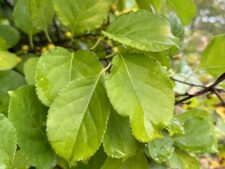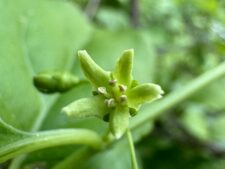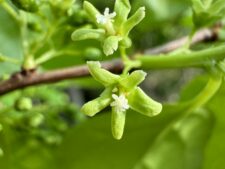
Native to southeast Asia, this aggressively invasive woody vine uses other vegetation as structural support, potentially girdling trees or damaging limbs. First introduced in the 1860s as an ornamental plant, it has become a cause of major environmental and economic damage in the hardwood forests of the eastern US. Undisturbed, vines may extend well into the canopy, growing up to 60 feet and 4 inches in diameter. It is often confused with its rarer native counterpart, American Bittersweet (Celastrus scandens).
Leaves are alternately arranged on the stem and are generally obovate to elliptical in shape (A,B). Flowers are clustered, small and green and grow from leaf axils (E – male, F – female). Fruits are numerous dehiscent yellow capsules (C) that open to expose reddish-orange arils (D) upon ripening.
Oriental Bittersweet may be distinguished from the native American Bittersweet by the location of fruits. Oriental Bittersweet will have clusters of fruit that extend from leaf axils all along the stem, while American Bittersweet will have fruit clusters only at the terminal ends of branches. In addition, Oriental Bittersweet has more rounded leaves than American Bittersweet, which has more egg-shaped leaves.
Oriental Bittersweet grows in a variety of environments, but is most commonly found in woodland edges and roadsides. At Neale Woods, it can be found along Neale Trail.
This species is a major focus of Fontenelle Forest’s land stewardship team’s invasive species control efforts. Bittersweet is being treated by brush cutting and treating the cut stumps with herbicide. NEVER PULL VINES GROWING IN OR ON TREES. Vines may have weakened or killed branches or entire trees. Pulling on vines can break or dislodge broken branches and cause them to fall, which can result in serious injury or death.
All photos courtesy of Drew Granville






